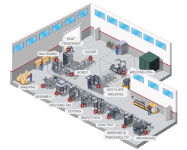2025 Automation Trends: Smarter, More Flexible, More Profitable
Automation in 2025 is changing the game, making equipment smarter, flexible, and better at delivering ROI. Modular automation leads this revolution, allowing businesses to reconfigure machines for new tasks, reducing costs, and boosting sustainability.
Modular Automation: The Future of Equipment
Forget rigid, single-purpose machines. Today’s modular systems adapt to changing production needs. Top innovations include:
- Bin Picking: AI-driven systems handle random objects with ease.
- Flexible Vision Sensors: One sensor for many tasks—no reprogramming needed.
- 6-Axis Robots: Versatile robots for complex, multi-directional tasks.
- Quick-Change EOAT: Switch tasks fast, cut downtime.
Why Servos Beat Pneumatics
Servos are replacing pneumatics for precision, efficiency, and control. These upgrades make modular systems even more powerful and profitable.
Rethinking ROI
Modular automation isn’t just about upfront savings. Think bigger:
- Repurpose Machines: One machine, endless tasks.
- Stay Flexible: Tackle demand shifts without delays.
- Go Green: Use less energy and reduce waste.
Top Tech for 2025
- Automated Assembly Machines: Customizable and efficient.
- Robotic Work Cells: From welding to screw fastening, they do it all.
- Traceability Solutions: Built-in marking and leak testing.
- Materials Handling Robots: Smooth, precise handling of parts.
What’s Next?
Businesses investing in modular automation now are setting themselves up for long-term success. These systems aren’t just tools—they’re strategies for staying ahead in a fast-moving market. With solutions like robotic welders, automated manufacturing cells, and smart assembly machines, the future is bright, flexible, and profitable.









